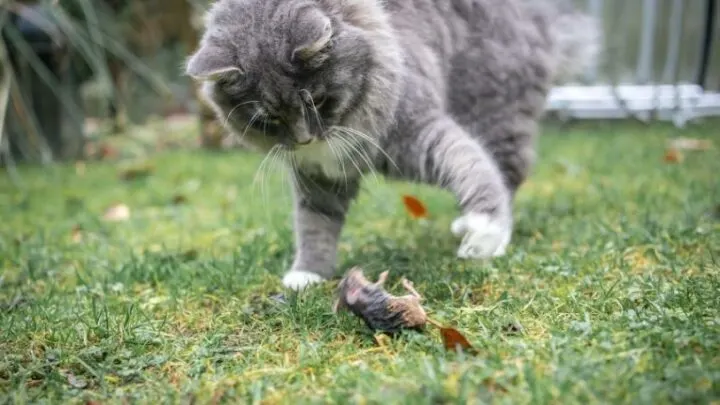Metaphors are a figure of speech where you compare something to another, unrelated thing.
Using them is a great way to build your fluency and speak well in any language.
English has many interesting metaphors, like using “let that sink in” to mean “understand that fully.”
Today, we’ll look at an animal-related metaphor, “look what the cat dragged in.”
What is the meaning of the phrase “look what the cat dragged in”?
The phrase “look what the cat dragged in” is used to point out someone’s arrival while also suggesting that you find them or their entrance disagreeable in some way. For instance, you could use this when someone is extremely late or if they look unkempt.
The image behind the metaphor “look what the cat dragged in”
Metaphors work by making a connection in the listener’s mind between a strong image of something unrelated and the actual topic of conversation.
In the case of “look what the cat dragged in,” the image that makes the metaphor work is that of the domestic cat as a hunter.
Cat owners will be nodding their head by this point, but if you’re not a cat person you might be confused.
If it’s about a cat hunting, why does it involve dragging? And why domestic cats instead of lions or tigers or something more deadly?
The truth is that domestic cats, just like their larger cousins, are highly-evolved killing machines.
In fact, they’re so effective at killing birds, lizards, rodents, and other small creatures that the Polish Academy of Sciences recently labeled them an invasive alien species.
If that sounds unrealistic, consider the case of the Stephen’s Island Wren, which was driven to extinction by a single housecat.
As for the dragging, this metaphor refers to the habit of some domestic cats to bring their kills home and leave them for their owners to find.
In other words, the image this phrase calls up is that of a cat killing a small animal and then dragging it home to display as a gross but well-intentioned gift.
The implications of “look what the cat dragged in”
As you might guess from the fact that it’s comparing someone to a dead animal, “look what the cat dragged in” isn’t exactly a compliment.
When you use this phrase in a conversation, it does two things.
First, it will draw attention to someone, putting them on display like the “present” the cat brings its owner.
It also suggests that you think they are worthy of scorn for some reason.
That can be because they’re poorly dressed or physically unkempt, but it can also relate to your opinion of them.
Finally, you can use this phrase to indicate that you haven’t seen someone for a long time, but keep in mind it will still carry those other negative implications.
When not to use “look what the cat dragged in”
The phrase “look what the cat dragged in” is a great choice if you’re among friends and family who are used to you poking fun at them.
However, if you don’t know the person you’re talking to very well or if you’re in a formal setting, telling someone this is not a good idea.
It’s definitely not an example of basic business English vocabulary.
Remember that you’re calling someone a dead animal.
While that can be funny if you know someone’s sense of humor, it can also be seen as a huge insult.
To be on the safe side, avoid using this at work, school, or anywhere else you might run the risk of being misinterpreted as rude and insulting.
Also, because this phrase is about calling attention to someone in the moment, it doesn’t make sense when written down.
Using “look what the cat dragged in” in a sentence
The saying “look what the cat dragged in” is very easy to use. That’s because, although we’ve called it a “phrase” in the sense that it’s a collection of words you can say, it’s actually a complete clause and works as a sentence on its own.
(See our article on clauses vs phrases for an explanation of the difference in these grammatical terms.)
If you want, you can add an interjection at the beginning. Interjections are words like “well” and “oh,” and they serve to draw attention to something you’re about to say.
If you do add an interjection before “look what the cat dragged in,” be sure to follow it with a comma.
Otherwise, there are no grammar rules to remember for this simple set phrase!
Look what the cat dragged in: Example Sentences
“Well, look what the cat dragged in. Finally decided to get out of bed, Steven?”
This example might take place in a family setting.
Perhaps it’s already after lunch, and Steven has just wandered downstairs looking bedraggled from a late night.
Although it’s not exactly polite, this usage would sound more joking than rude. Note that the interjection “well” is separated from the phrase by a comma.
“Look what the cat dragged in! Can you believe she had the nerve to come back here after what happened last week?”
In this example, however, the second sentence makes it pretty clear that this is an insulting use of the phrase.
“Oh, look what the cat dragged in. I thought you’d moved away for good!”
Here, the speaker is talking to someone they haven’t seen for a long time.
Although it might be taken in good humor, there’s always the chance for something like this to sound rude.
Make sure you keep your tone of voice and facial expressions positive if you’re not trying to insult someone.

Hey fellow Linguaholics! It’s me, Marcel. I am the proud owner of linguaholic.com. Languages have always been my passion and I have studied Linguistics, Computational Linguistics and Sinology at the University of Zurich. It is my utmost pleasure to share with all of you guys what I know about languages and linguistics in general.

